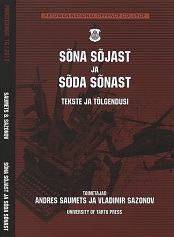Community Interpreting - kuidas seda tõlkida?
Community Interpreting - How To Translate It?
Author(s): Katrin KaruSubject(s): Language and Literature Studies
Published by: Kaitseväe Ühendatud Õppeasutused
Summary/Abstract: In present-day translatology, community interpreting is an independent object of research. In specialist literature, there are various definitions of this concept, but quite often different terms are used to denote the same phenomenon. There are multiple reasons for this terminological inconsistency – they can be due to traditions of different countries, to unsettled traditions, or simply to preferences of the authors. The general consensus is that community interpreting is a type of interpreting used by official institutions in order to enable communication between an official and a client who is not familiar with the official language of the country so that the latter could have equal access to legal, health, educational and social services. In Estonian, there is no established equivalent for the term community interpreting. Attempts have been made to find genuinely Estonian equivalents for the English term community interpreting, or to adopt a foreign term. The need for terminological unity in the area is of utmost significance. Interpreting, in its essence, is a public service that is provided by, among others, translation agencies, so it is important that non-experts who are not acquainted with the terminology and conceptual system of translatology should be able to decide which service suits them and whether it is offered to them. Therefore the transparency and semantic motivatedness of the term are essential characteristics to be kept in mind when choosing the term. The term that is going to be adopted should be simple and easily understandable. The article takes a closer look at Estonian terms that have been used as equivalents for the English term community interpreting and considers their appropriateness for denoting the concept. The following terms are discussed: liaisontõlge, dialoogtõlge, kogukonnatõlge, kontakttõlge, olmetõlge, asjaajamistõlge.
Journal: KVÜÕA toimetised
- Issue Year: 2012
- Issue No: 16
- Page Range: 73-86
- Page Count: 14
- Language: Estonian

